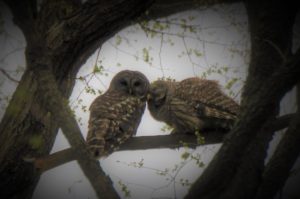Photography courtesy of Lowell Washburn, all rights reserved.
The winter and spring calls of the barred owl are among my favorite woodland sounds. While most owls reserve their calling for the nighttime hours, the signature “who cooks for you” cry of the barred owl is as likely to be heard at noon as midnight.
The larger and more ferocious great horned owl is the first bird to begin nesting in Iowa each year, and this year’s crop of horned owl babies are already preparing to leave the nest. By contrast, the barred owl’s nesting cycle is still in its early stages. In southern Iowa, pairs are sitting on eggs or downy young; while in extreme northern Iowa, many breeders have yet to lay their first egg.
Of all the owl species to inhabit our Iowa woodlands, none produce more volume or generate a greater variety of calls than the barred owl. For anyone who enjoys listening to the owls, there’s no better time to be in the timber than right now. In addition to the trademark “who cooks for you; who cooks for you all” calls; the barred owl also adds many additional sounds to its repertoire during the spring nesting season. I won’t [and can’t] attempt to describe the nocturnal caterwauling. Let’s just say that the sounds are extremely loud and extremely varied. To the uninitiated, they might even seem downright scary.
A few nights ago, my son Matt and I found ourselves sitting in a dark, predawn woodland – him with a bow; me a camera — hoping to catch a glimpse nearby wild turkeys when they came off the roost at daylight. We’d set up smack in the middle of an active barred owl nesting territory; I’d been listening to the birds, off and on, for several mornings. Something about this day must have been exceptional, however. At the first approach of dawn, the pair’s male went absolutely off his rocker. Going deep into what I’ll refer to as “Full Monkey Mode”, the owl was making the woodland echo with his bizarre calls. Every now and then, the female would answer from a distance. Following several minutes of communication, we could tell that the female was moving closer. That’s when things really began to get interesting.
Flying to a horizontal limb located over our position, the male toned it down and began a soft, almost cooing, set of calls. After responding with the species’ distinctive standard call, the female soon arrived and joined her mate on the same branch. Although separated by at least three feet, the male soon began to slowly inch closer to the larger female. When they eventually touched shoulders, the female suddenly began to accompany her mate in the cooing serenade. “Love Birds” was the thought that came to mind.
As the calling continued, the male began to gently preen the female’s neck feathers with his hooked bill – an oddly gentle display for a rodent slaying predator. Returning the favor, the female soon began preening the male’s neck and wing. The male responded by cuddling up to her like a happy puppy. Even though the light was still to dim for anything good, I slowly eased the camera into positon and obtained a couple of grainy voucher photos. Although I’ve been listening to and observing barred owls for decades, I’d never before heard those soft sounds nor witnessed that behavior. I chalked it up as another excellent example of why we should never miss an opportunity to get into the Iowa outdoors.



 Tom Cope
Tom Cope Sue Wilkinson
Sue Wilkinson Susan Judkins Josten
Susan Judkins Josten Rudi Roeslein
Rudi Roeslein Elyssa McFarland
Elyssa McFarland Mark Langgin
Mark Langgin Adam Janke
Adam Janke Joe Henry
Joe Henry Kristin Ashenbrenner
Kristin Ashenbrenner Joe Wilkinson
Joe Wilkinson Dr. Tammy Mildenstein
Dr. Tammy Mildenstein Sean McMahon
Sean McMahon